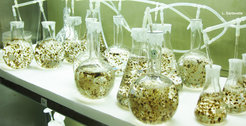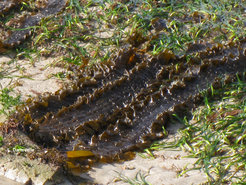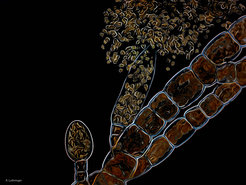Origin and Evolution of Sexual Systems
Coelho Lab
The evolution of eukaryotic sex and sex-related phenomenon have engaged and intrigued biologists for centuries. Although the core processes that define meiotic sex (meiosis and syngamy) are largely conserved, sex determination systems are bewilderingly diverse, and have had rapid transition rates during evolution. Their intriguing evolutionary dynamics raises important, still unanswered, questions. How do haploid sex chromosomes evolve? What are the genetic bases and the genomic consequences of shifts in sexual systems? Why do transitions occur more often in some groups than in others, and why are some sexual systems found more frequently than others? What are the driving forces underlying these transitions?
ERC Starting Grant SEXSEA: Sex determination and the evolution of sex chromosomes (2015 – 2020)

We are investigating the evolution of sex chromosomes across the whole brown algal clade. We use Ectocarpus and other closely related brown algal species to understand the mechanisms underlying sex determination in this group. We identified a candidate master sex determination gene and we are studying how this gene, together with autosomal genes, coordinates the development of a male versus female fate.
ERC Consolidator Grant TETHYS: The evolution and regulation of major transitions in sexual systems: new insights from the brown algae

We are generating and exploiting genomic datasets (e.g. 50 reference genomes, transcriptomes, and several genetic maps across the phylogeny of the brown algae), and the amenability of model brown algae to genetic approaches to uncover the genetic causes, mechanisms and evolutionary forces driving switches between separate and combined sexes and transitions from haploid to diploid sex determination. More information here.
Regulation of sexual development across brown algal species

We explore comprehensive, time-resolved, transcriptional and chromatin state roadmaps for sexual development across brown algal species representing a range of sexual systems, levels of morphological complexity and levels of sexual dimorphism. We aim to shed light into the genetic and regulatory programs involved in sex determination and differentiation and to investigate the evolutionary dynamics of chromatin composition and its impact in genome function and evolution.
Linking ecological factors to the evolution of sexual systems

We use databases and phylogenetic comparative methods to examine patterns of correlated evolution between sexual, morphological and genomic traits in a phylogenetic context, in order to link ecological factors with reproductive transitions. These large-scale databases also allow us to evaluate the consequences of shifts between sexual systems on genome structure and species diversification. Our goal is to elucidate the dynamics of sexual system evolution at the macro-evolutionary level, and to reveal ecological drivers of transitions between sexual systems in the brown algae.
Genetic basis and plasticity of developmental programs during brown algal reproduction

In many brown algae, and within a single life cycle there is an extraordinary plasticity in terms of developmental programs. We are investigating the genetic pathways involved in gamete parthenogenesis. Interestingly, natural populations of brown algae reproducing exclusively via parthenogenesis exhibit reduced sexual traits (e.g. decay in pheromone production) and have acquired more prominent asexual traits. We are exploring these populations to understand the genomic and evolutionary consequences of the transition to asexuality.




